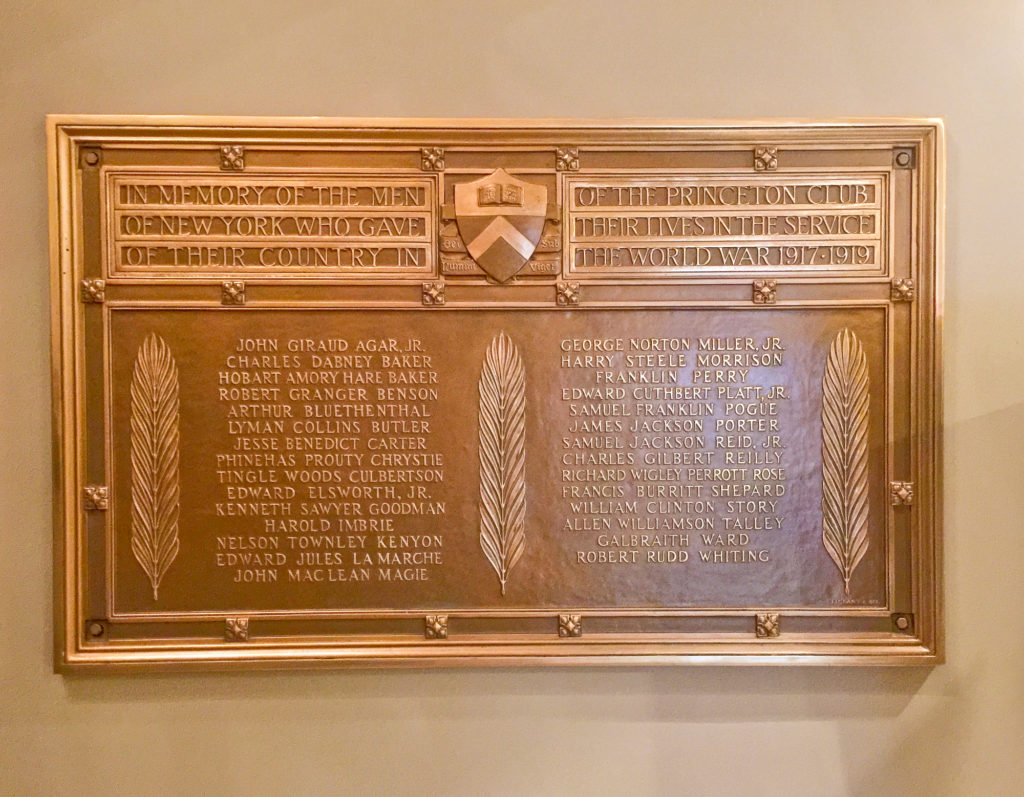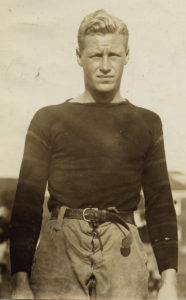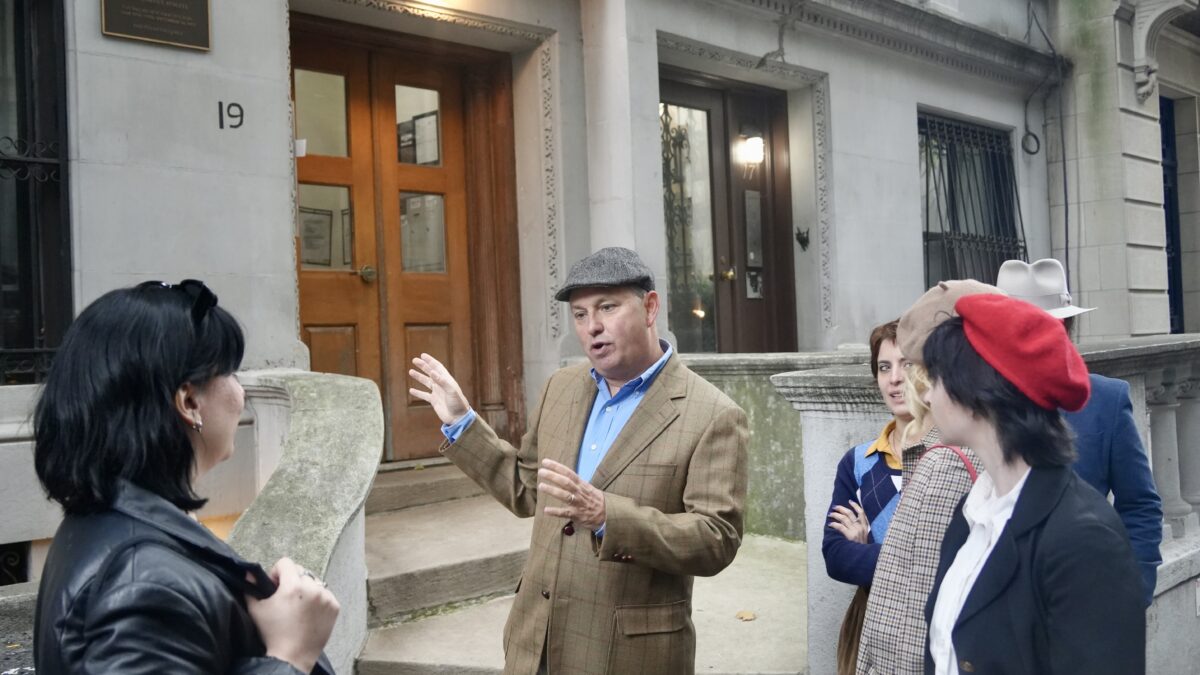
John Giraud Agar, Jr., Class of 1914
First Lieutenant, 22nd Aero Squad, 1st Division. Following a patrol over the St. Mihiel Sector, Agar died of injuries suffered in an air crash on October 21, 1918. Agar was 25. He is interred in Suresnes American Cemetery, France. Agar is also on the Columbia University Honor Roll, Class of 1919, School of Physicians and Surgeons.
Charles Dabney Baker, Class of 1913
Captain, Company E, 165th Infantry (Fighting Sixty-Ninth), died of wounds he received in action on September 12, 1918. Awarded Croix de Guerre.

The football and hockey star, Hobey Baker. Captain in the 141st Aero Pursuit Squadron, credited with four planes shot down. He was killed while testing a newly repaired plane on December 12, 1918.
Robert Granger Benson, Class of 1915
U.S. Army Quartermaster Sergeant and Master Engineer, accidental death in France, October 27, 1918. Age 26.
Arthur Bluethenthal, Class of 1913
Volunteer with American Field Service ambulance corps 1916. Enlisted in French air corps 1917. Pilot in the Lafayette Escadrille, killed in action on June 5, 1918. He was posthumously awarded the Croixe de Guerre, French War Cross, with two citations.
Lyman Collins Butler, Class of 1910
Sergeant, Company K, Seventh Regiment, New York National Guard. Died June 20, 1917, after being struck by subway car at Grand Central Terminal. Age 29. Interred Woodlawn Cemetery, the Bronx.
Jesse Benedict Carter, Class of 1893
He was a Professor of Latin at Princeton from 1902 to 1907. Civilian volunteer. Died in Red Cross Service at Cervignano, Italy, on July 20, 1917. Posthumously decorated Commander of the Crown of Italy. Carter is interred in Rome.
Phineas Prouty Chrystie, Class of 1912
Captain, Instructor at the Fire School in Fort Sill, Oklahoma, when he was killed by an accidental explosion February 6, 1918. Age 28.
Tingle Woods Culbertson, Class of 1911
Volunteer with American Field Service ambulance corps 1916. Survived U-Boat attack aboard the Sussex in 1916. Commissioned U.S. Army, First Lieutenant, 318th Infantry Regiment, 80th Division. Killed in action October 4, 1918, in the Meuse-Argonne Offensive.
Edward Elsworth, Jr., Class of 1911
Lieutenant, killed in action October 20, 1918. Posthumously awarded the Distinguished Service Cross. Citation reads: “for extraordinary heroism in action while serving with 6th Engineers, 3d Division, in the Claires-Chenes Woods, France. When two machine-gun nests were holding up the advance of his company, Lieutenant Elsworth took three soldiers and by daring and skillful maneuvering captured both guns. Later in the same day Lieutenant Elsworth charged another machine-gun nest and was killed.”
Kenneth Sawyer Goodman, Class of 1906
Lieutenant, died two weeks after the Armistice, November 30, 1918, of pneumonia in Chicago before seeing action.
Harold Imbrie, Class of 1900
First Lieutenant, Army Signal Corps, Air Service, died of disease in service in Wichita Falls, Texas, April 25, 1918.
Nelson Townley Kenyon, Class of 1916
Wounded in action on November 6, and died on November 9, 1918 two days before the armistice was signed. He is interred in Woodlawn Cemetery.
Edward Jules Lamarche, Class of 1915
First Lieutenant, Headquarters Company, 15th Artillery Regiment, died in line of duty in Germany (American Army of Occupation) July 12, 1919. Interred Arlington National Cemetery.
John Maclean Magie, Class of 1892
Captain, Quartermaster Corps, died December 5, 1918, of pneumonia at St. Nazaire, France. Before the war he was a prominent journalist, working on the staff of the New York Tribune and Harper’s Weekly.
George Norton Miller, Jr., Class of 1910
Born in Rhinebeck, Second Lieutenant, 360th Aero Squadron, Third Pursuit Group, died of disease in Germany (American Army of Occupation) March 27, 1919. Miller was 31. He is interred in Green-Wood Cemetery, Brooklyn.
Harry Steele Morrison, Class of 1905
Before the war Morrison was a successful author of young adult adventure books; he met Queen Victoria and the Pope. Morrison volunteered for civilian war service and died in Washington, D.C., January 14, 1918.
Franklin Perry, Class of 1911
Master Signal Electrician, U.S. Army Signal Corps, 26th Aero Squadron, died of cerebral spinal meningitis December 29, 1917. He was 30. Perry, of Elmhurst, Queens, was the first member of 1911 to die in the Great War. He’s interred in St. Mihiel American Cemetery, Thiaucourt.
Edward Cuthbert Platt, Jr., Class of 1901
Lieutenant, Canadian Infantry, Quebec Regiment, killed in action in Passchendaele, Belgium, November 7, 1917. Age 38. Platt is interred in Passchendaele New British Cemetery, Flanders, Belgium.
Samuel Franklin Pogue, Class of 1904
Before the war Pogue was vice-president of his family dry goods company in Cincinnati. He was commissioned a Captain in the U.S. Army Quartermaster Corps, and was assigned to Washington. On December 12, 1918, he fell victim in the influenza pandemic, and died of typhoid pneumonia.
James Jackson Porter, Class of 1911
Second Lieutenant, 10th Machine Gun Battalion, 4th Infantry, killed in action near Brienlles, October 5, 1918. He was 27. Porter is interred in Meuse-Argonne American Cemetery.
Samuel Jackson Reid, Jr., President of the Class of 1906
From Brooklyn Heights. First Lieutenant, Battery A, 306th Field Artillery, killed in action during the Somme Offensive, August 22, 1918, age 34.
Charles Gilbert Reilly, Class of 1912
A civil engineer, Reilly entered the first Plattsburg civilian officer training camp in 1917 and earned a commission. He was a captain with Company D, 313th Infantry, 79th Division, arriving in France in July 1918. He was killed in action in the Argonne Forrest on September 29, 1918.
Richard Wigley Perrott Rose, Class of 1916
Corporal, 67th Company, Fifth Regiment, Second Division, U.S. Marine Corps. Wounded in action on the first day of the attack in Belleau Wood. Recovering in a Paris hospital, it was necessary to amputate his leg. Rose died two days later, June 24, 1918, age 24. Rose is interred in Suresnes American Cemetery, France.
Francis Burritt Shepard, Class of 1906
Captain, 313th Field Artillery Regiment, 80th Division. Died of tuberculosis December 16, 1918. Shepard is interred in Suresnes American Cemetery.
William Clinton Story, Class of 1913
From Freeport, Long Island, Aviation Cadet, U.S. Army Signal Corps. Died on February 26, 1918 in an airplane training collision at Park Field, Memphis, Tennessee. He was 25.
Allan Williamson Talley, Class of 1916
From West 89th Street, Manhattan. First Lieutenant, 5th Machine Gun Battalion, 2nd Division. Killed in action during the Meuse-Argonne campaign, October 7, 1918. He was 23. Talley is interred in Meuse-Argonne American Cemetery. He was posthumously awarded the Croixe de Guerre, French War Cross.
Galbraith Ward, Class of 1915
Sergeant, Company M, 306th Infantry Regiment. Awarded Distinguished Service Cross for heroism and bravery for rescuing wounded soldiers. Died of pneumonia on December 17, 1918. His brother, Corporal Marquand Ward, 312th Infantry Regiment, Class of 1917, had been killed in action two weeks earlier, October 18, 1918. The brothers are interred next to each other in the Meuse-Argonne American Cemetery.
Robert Rudd Whiting, Class of 1901
He acted in the Triangle Club and wrote humor for The Tiger. Before the war he was a journalist on the New York Sun and a magazine editor. Whiting was turned down for active service due to his age and frailty. He joined the war effort in public relations. Whiting died in the influenza pandemic October 15, 1918 while working for the Committee on Public Information in Washington.
